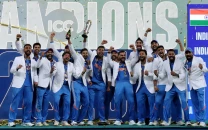Comment: Pakistan search for answers as brittle batting crumbles again
Batsmen from around the world continue to cane bowlers as Pakistan batsmen continue to disappoint their followers.

SHAMBOLIC RUN: Pakistan’s batting line-up capitulated yet again in an ODI, adding immense pressure on an already curtailed bowling attack in the first match against New Zealand at Wellington. PHOTO: AFP
Batsmen from around the world continue to cane bowlers in the power packed ODIs of late as Pakistan batsmen continue to disappoint their followers.
Another shoddy display, despite fielding an eleven packed with batsmen, cost Misbah’s men the opening ODI of the two-match series against New Zealand at Wellington’s Westpac Stadium.
Shorn of bowling talent, Pakistan decided to take the field with as many as nine batsmen, including all-rounder Shahid Afridi, Bilawal Bhatti and Sarfraz Ahmed. However, the batting remained drab and inept.
While the conditions were nowhere close to unplayable, the top order of Muhammad Hafeez, Ahmed Shehzad and Younus Khan returned to the hutch inside the first 15 overs. After a brief respite, the ‘spooked’ Haris Sohail fell after a largely unconvincing innings of 23.
Umar Akmal and Sarfraz perished to ill-judged shots. Misbah fought doggedly, but once again failed to carry on till the end, and only Afridi’s pyrotechnics took the men in ‘lime-green’ past the 200-run mark.
Pakistan’s think-tank is lamentably yet to come to terms with the loss of Hafeez—the bowler. Head coach Waqar and Co are still ruffled by Professor’s absence at the bowling crease and are not willing to play the extra bowler at the cost of a batsman.
The writing is on the wall, but the ones concerned are stubbornly refusing to realise that batting is not Pakistan’s strength and if five batsmen fail to do the job, six or seven are not going to make much of a difference.
By providing ‘cushion’ to the batsmen, Pakistan’s traditional strength bowling is being compromised. The elevens fielded in the last six ODIs are unbalanced with the absence of a regular fifth bowler.
Sarfraz and Afridi provide immensely valuable batting options, and one feels that sooner rather than later, the wicketkeeper is going to open the innings with Shehzad, especially if Hafeez fails to clear the bowling action test scheduled for February 6. But the million dollar question for now remains: when is the think-tank likely to wake-up?
Critics are also questioning Younus’ contribution as the number three batsman — the fulcrum of the batting order. Other than his century in a losing cause at Abu Dhabi last December, the ace Test batsman’s returns in recent ODIs remain ordinary.
Pakistan’s woes are not restricted to the misfiring batting line-up only, the pace and spin attack other than Afridi and Muhammad Irfan lack in quality. Bilawal is still struggling to make a sustained impact at the highest level, while Ehsan Adil, who featured in the Wellington loss, also had a fairly forgettable game.
The lack of depth in the bowling resources are being accentuated by the negative mindsets in the Pakistan camp, which is focused primarily on shoring up the batting resources. Most teams are aiming to post 300-plus scores and almost all of the seven leading teams sans the 1992 champions seem to possess the ammunition for the task.
Even a packed batting line-up is failing to do the trick for Misbah’s men.
Now with only one more game before the commencement of the World Cup, Pakistan must ensure that the four players benched in the first game (Sohaib Maqsood, Yasir Shah, Sohail Khan, and Wahab Riaz) get to play the second ODI at Napier. All 15 players should have a run and a taste of the pressures of playing in alien conditions ahead of the demanding tournament.
The team management needs to address the issues at hand immediately, striking the right balance for the eleven should be the topmost priority.
The fact remains that there is little point in shoring up the batting department at the cost of the bowling resources, since historically, Pakistan have not been consistent in the ODI format with bat and the follies of more than two decades are not likely to be rectified merely a fortnight before the World Cup.
Published in The Express Tribune, February 1st, 2015.
Like Sports on Facebook, follow @ETribuneSports on Twitter to stay informed and join in the conversation.


















COMMENTS
Comments are moderated and generally will be posted if they are on-topic and not abusive.
For more information, please see our Comments FAQ